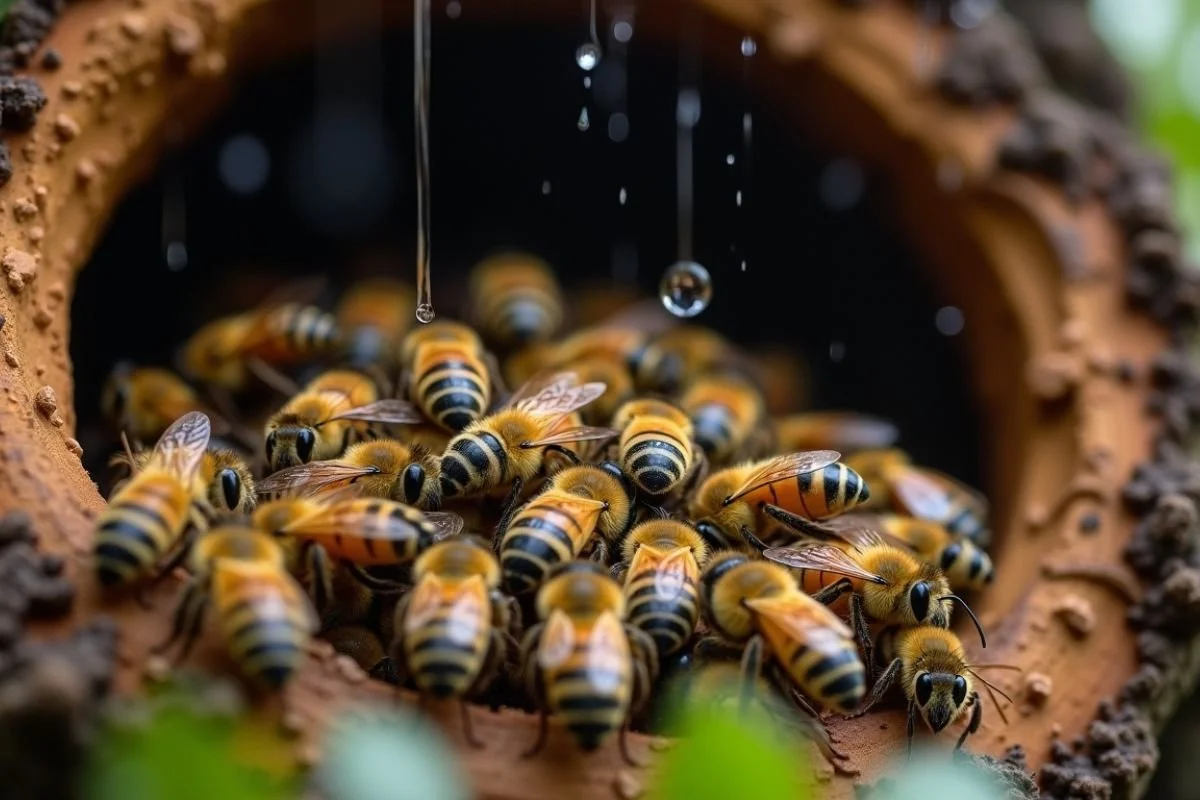🌧️ What Happens to Bees During Florida’s Rainy Season?
Florida’s rainy season, typically from May through October, is known for its heavy downpours, high humidity, and dramatic thunderstorms. While the rain brings life to plants and replenishes our environment, it also creates a challenging time for many insects, including honey bees. So, what exactly happens to bees during Florida’s wettest months? Do they continue to pollinate in the rain? Do hives get flooded? And how does it affect bee removal or relocation efforts?
Let’s dive into how bees adapt to Florida’s stormy months, what risks they face, and what homeowners should know during this soggy season.
🐝 Do Bees Fly in the Rain?
Short answer: rarely. Bees are incredibly sensitive to weather. While a drizzle might not deter them completely, heavy rain or high humidity usually grounds them.
Why Bees Avoid Rain:
Waterlogged Wings: A bee’s wings are thin and delicate. Raindrops can weigh them down, making it difficult—if not impossible—to fly.
Navigation Trouble: Overcast skies and rain interfere with the sun’s position, which bees use for orientation.
Temperature Drops: Bees are cold-blooded, and flying becomes dangerous when temperatures dip, especially in rainy conditions.
When Do Bees Come Out?
You’ll usually see bees foraging during the dry spells—often in the morning or early afternoon when Florida's weather is more stable.
🐝 What Happens Inside the Hive During Rain?
Bees seek shelter under a soffit as Florida’s rainy season pours down.
Bees are incredibly resourceful. During long periods of rain, they shift from foraging mode to survival mode, focusing on:
Conserving energy
Tending to the queen and brood
Protecting and sealing the hive from moisture
Hive Defense Tactics:
Sealing Gaps with Propolis: Bees produce a sticky substance called propolis, which they use to plug leaks and cracks.
Cluster Behavior: Bees huddle together to maintain warmth and protect the queen.
Reduced Activity: With less food coming in, bees limit their movement to conserve stored honey.
In some cases, prolonged rain can lead to starvation, especially in smaller or new colonies without enough honey stores.
🌧️ Does Rain Damage Bee Hives?
Yes, especially wild or poorly protected hives.
In Florida, bees often build hives in:
Bee colony shelters under a home’s roof edge during Florida’s rainy season.
Tree hollows
Roof soffits
Wall cavities
Old sheds
Abandoned grills or furniture
Risks of Rain to Hives:
Water Intrusion: Heavy rain can seep into hives, soaking the comb and killing larvae.
Mold Growth: High humidity promotes fungus inside the hive.
Hive Collapse: In extreme cases, flooding can destroy the structure entirely.
Man-made structures, such as attics or walls, may shelter bees better than tree hives, but they still pose risks, especially if rain leaks into the home or softens building materials around the colony.
🐝 Do Bees Swarm During Rainy Season?
Swarming typically happens in spring, but in Florida’s tropical climate, it can continue into the rainy season, especially when the rain is inconsistent. After a brief dry spell, bees may take the opportunity to:
Split the colony
Look for a new nest
Follow the queen to a drier, safer location
Swarming + Rain = Trouble
If a swarm relocates during a rainstorm, they may settle in vulnerable places, like under a porch, inside a carport, or even in a soffit. Once there, they can establish a hive in as little as 48 hours.
🌼 How Does Rain Affect Bee Foraging and Pollination?
Rainy weather directly impacts Florida’s ecosystem and food supply because:
Bees pollinate 1 in every 3 bites of food we eat.
Prolonged rain means fewer flights, which means less pollination.
This affects crops like citrus, avocados, melons, and wildflowers.
Less Pollination = Fewer Flowers
Bees may miss flowering windows, leading to a decline in plant reproduction. It’s especially noticeable in:
Backyard gardens
Orchards
Local farms
This is why bee-friendly gardening practices and habitat conservation are crucial, even during the rainy months.
🏡 What Should Homeowners Watch for During the Rainy Season?
Rain makes it easier for bees to move into homes unnoticed. Wet or rotting wood and structural gaps offer the perfect entry points.
Signs of Bee Activity After Rain:
Buzzing near soffits or vents
Bees are disappearing into cracks in walls
Puddles near a hive site (indicating water retention inside)
Strange, damp smells (from honey fermentation)
Bees flying into your attic or crawlspace during a dry break
⚠️ Important: Never try to seal up a hole while bees are active inside! It could cause them to panic and move deeper into the home or become aggressive.
🐝 How Bee Removal Changes During Rainy Season?
Honeybees sheltering inside a hive on a rainy day.
Professional bee removal gets more complicated during Florida’s wet months. Here's why:
Wet Weather Challenges:
Slippery roofs and ladders create safety risks.
Hives may be harder to access due to flooding or waterlogged materials.
Bees are more defensive after being stuck inside.
But It’s Still Possible:
Reputable eco-friendly bee removal companies—like Eco Bee Removal—are equipped to handle these conditions using:
Thermal imaging to locate colonies
Protective enclosures to prevent rain damage during removal
Live relocation methods to save the colony and avoid extermination
🐝 How You Can Help Bees During Florida’s Rainy Season
Even though the rainy season brings challenges, there are several ways you can support bees at home or in your community:
Simple Actions with Big Impact:
✅ Plant native flowers that bloom during the wet season
✅ Avoid spraying pesticides, especially near flowering plants
✅ Let dandelions or clover grow during breaks in mowing
✅ Place shallow water sources for bees to drink
✅ Call a professional if you suspect a hive inside your walls or attic
🌧️ Final Thoughts: Rain, Bees, and Balance
Bees are remarkably resilient, but Florida’s rainy season forces them to make serious adjustments. From delayed foraging and hive damage to accidental infestations in homes, wet weather challenges both bees and homeowners alike.
Whether you’re a gardener, a farmer, or simply someone who cares about the environment, understanding how bees respond to the rain can help you act responsibly—and maybe even save a colony or two.
If you spot a hive during the rainy season, remember:
Leave it to the professionals.
Choose eco-friendly bee removal and relocation services.



